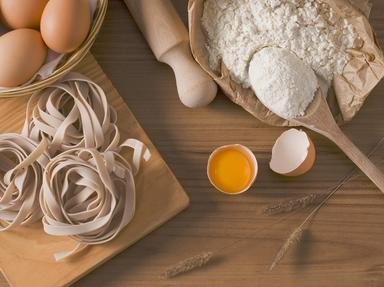Quiz Answer Key and Fun Facts
1. Drizzle is a kind of light rain with tiny raindrops; freezing drizzle is what produces black ice on roadways. What does it mean when a recipe asks you to drizzle something over something else?
2. Our chef returns from a U.S. tour of the mid-Atlantic states and is eager to make scrapple. In addition to cornmeal, what is the other principal ingredient in scrapple?
3. If a dish is garnished so as to make it amandine, what is added?
4. What is the difference between molasses and treacle?
5. Allen Ginsberg, William S. Burroughs and Jack Kerouac were all part of the Beat Generation. The heart of rock-n-roll is the beat. Which of the following may be used when a recipe directs one to beat a mixture?
6. A chef visiting from Australia asks for some verjus or verjuice with which to make a salad dressing. What is chef asking for?
7. What is the difference between bread flour and cake flour?
8. Johann Sebastian Bach wrote a series of preludes and fugues in all major and minor keys which he published in 1722 under the title "The Well-Tempered Clavier." The Roman Emperor Nero (37-68 AD) was reputed to have an awful temper. Steel is tempered; glass is tempered. How does one temper chocolate?
9. Cholent -- a slowly simmered stew of meat (beef, chicken or sausage), potatoes, beans, barley (or rice) -- is especially associated with people of one particular religion. Which is it?
10. The chef de patisserie "suggests" that you blind bake the crusts for the French silk chocolate pies. What does she want you to do?
Source: Author
FatherSteve
This quiz was reviewed by FunTrivia editor
WesleyCrusher before going online.
Any errors found in FunTrivia content are routinely corrected through our feedback system.


